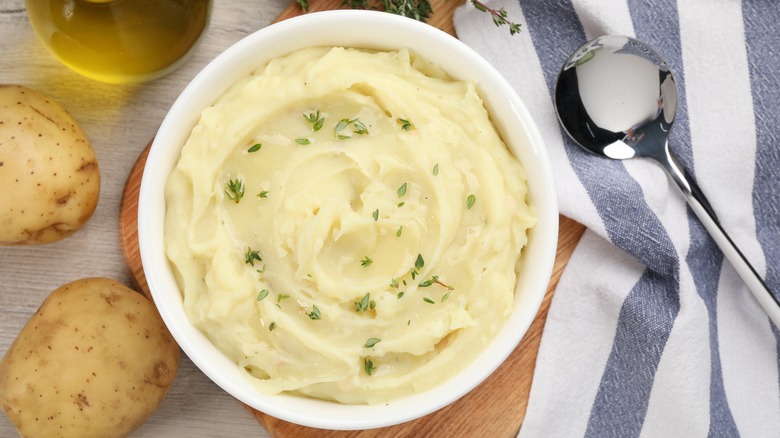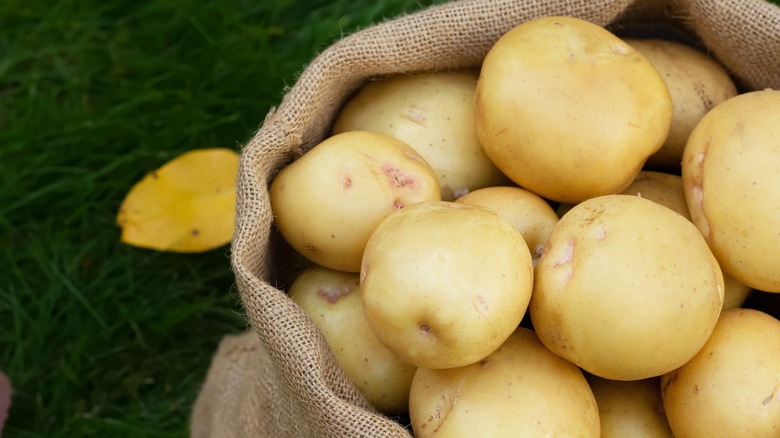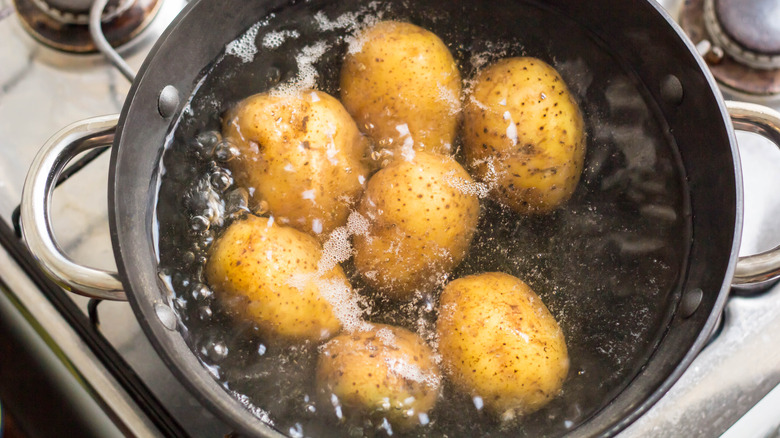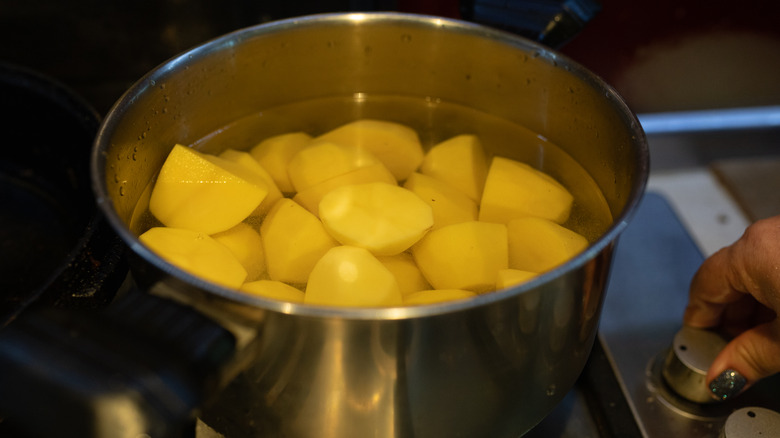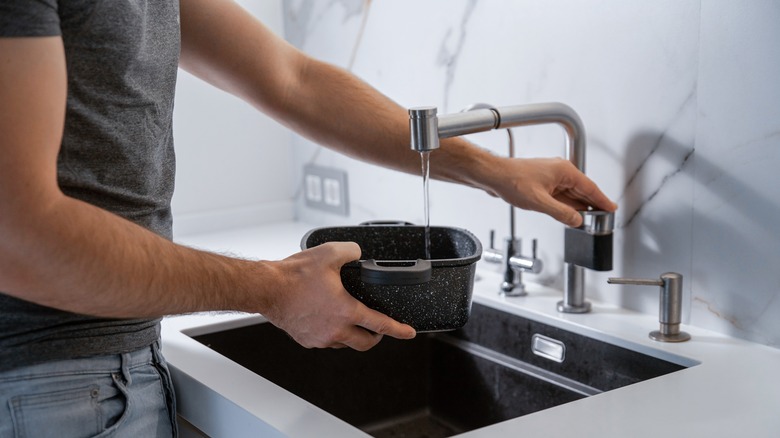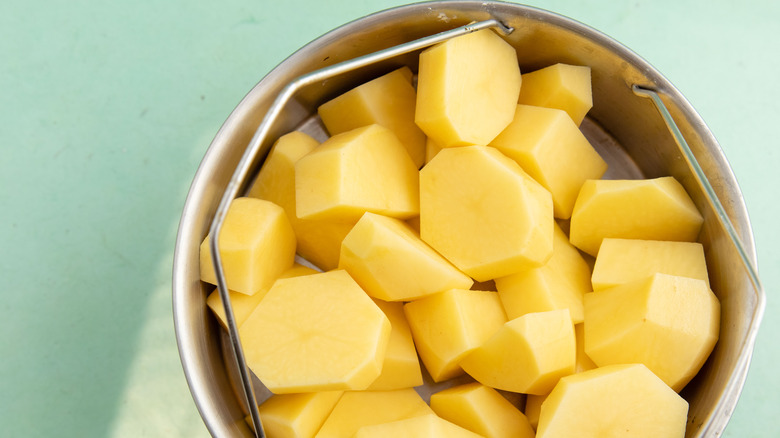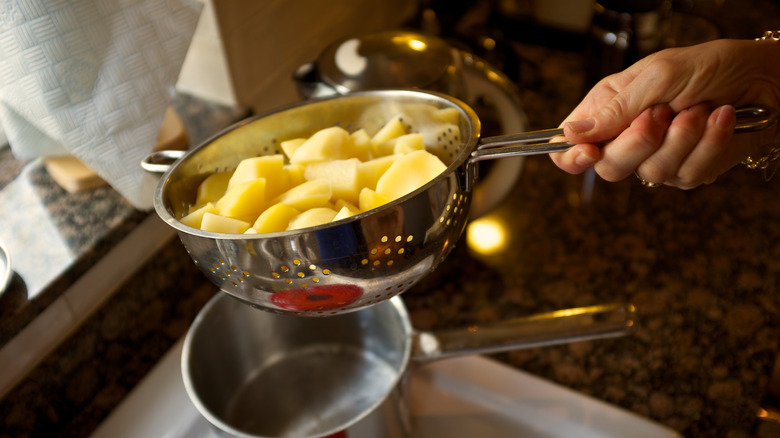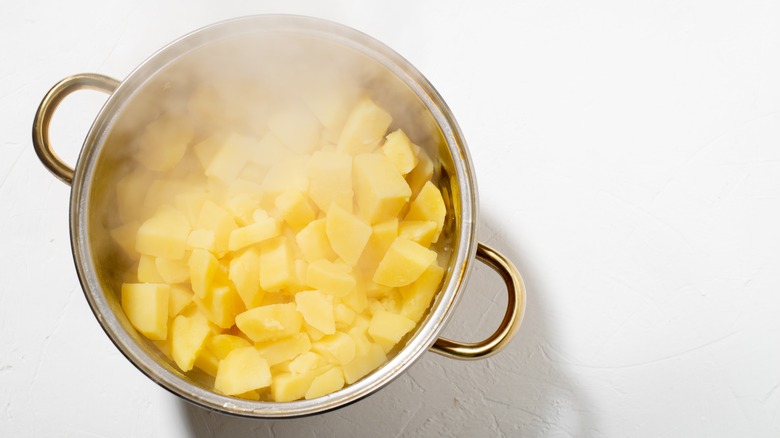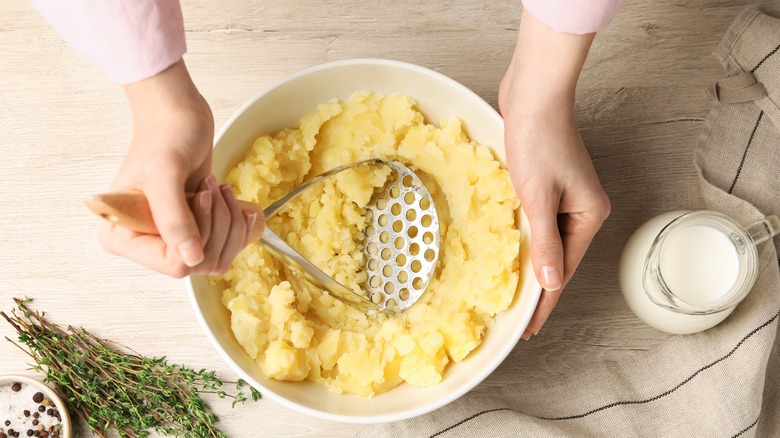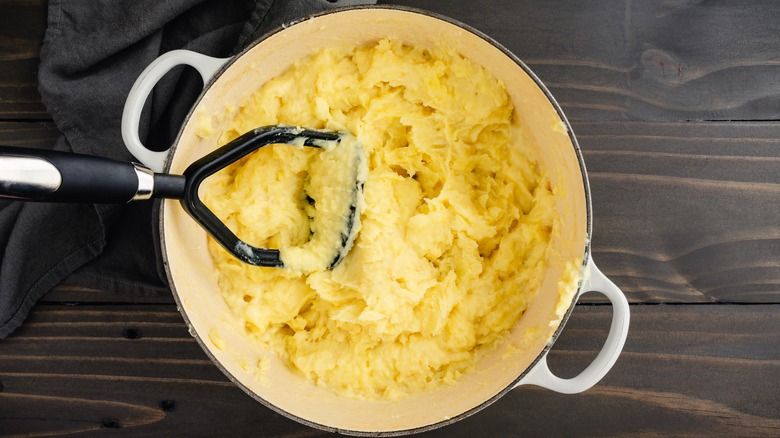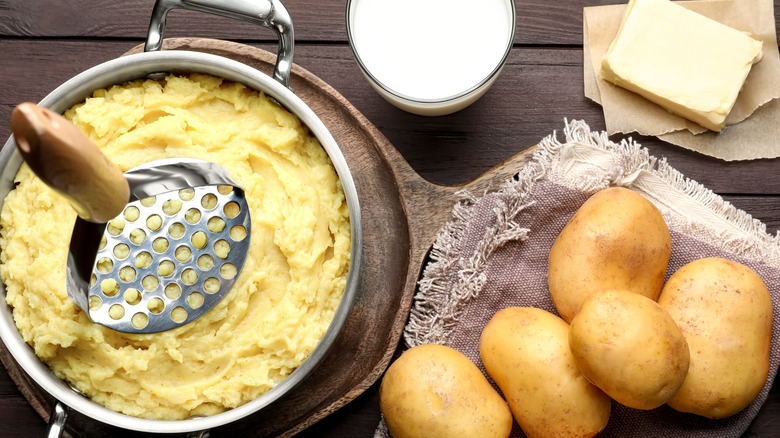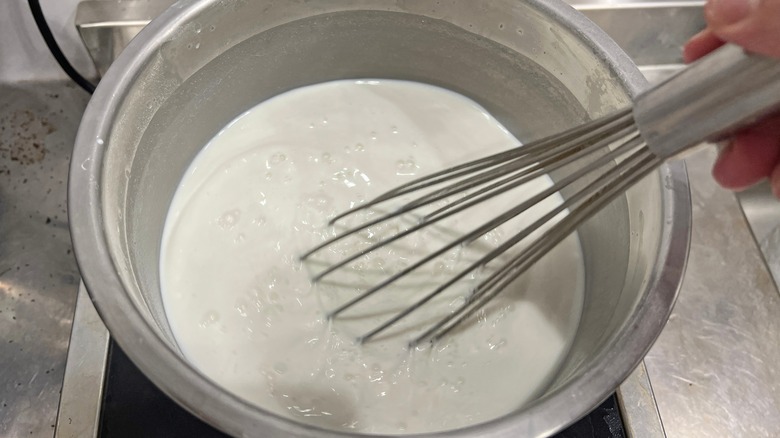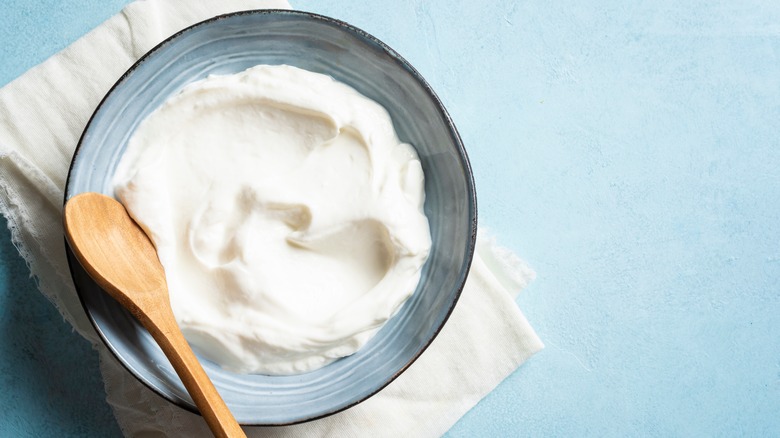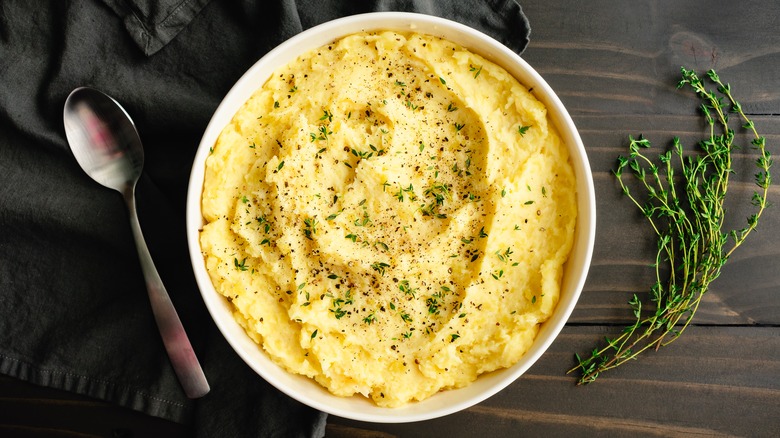13 Expert Tips For Making The Creamiest Mashed Potatoes
Not many dishes are as comforting as a bowl of freshly made traditional mashed potatoes. The combination of velvety smooth texture and subtle potato flavor results in a side dish that makes a perfect sidekick to almost any entree. It shows its best qualities when paired with other homey classics such as meatloaf, roasts, steaks, and sausages, and it truly shines when it teams up with luscious gravy. It is a dish fit for both fine dining menus and hole-in-the-wall establishments but, perhaps most of all, it's a side dish we will most likely make at home.
As it's such an ultimate classic, we're constantly looking for ways to perfect mashed potatoes. This time, we wanted to focus on texture and assemble all the tips and tricks that help the mash attain ultimate creaminess. To be absolutely sure that the tips are on point, we consulted several experts, namely chef Ann Ziata from the Institute of Culinary Education's New York City campus; classically trained chef Dennis Littley, who knows all about comforting classics; and Jessie Johnson, the founder and recipe developer at Life As A Strawberry culinary blog.
Our experts addressed every step of the mashed potato process and provided valuable advice on how to properly choose, prep, cook, and mash the spuds to achieve a perfectly smooth texture.
1. Choose the right potato variety
The preparation of the creamiest mashed potatoes starts with the right variety of potato. This step dictates the course and success of the dish, making it one of the non-negotiables when it comes to mashed potatoes.
Our experts all agree that Yukon Gold is the winner for the category. "These potatoes have a waxy, creamy texture that mashes beautifully and has a smooth, buttery finish," explains Johnson. She also suggests that this variety will yield a "creamy, restaurant-quality mashed potato." Littley also praises Yukon Gold's texture, which is ideal for mashing. Ziata adds that this is the perfect variety as it falls in the medium starch category, meaning it won't release too much starch into the mash. She clarifies, "you want enough starch to be released to attain creaminess, but not too much so that it becomes gummy."
As an alternative, Johnson suggests red potatoes. She cautions that this waxy variety, which has a different texture than starchy potatoes, might not give you the creamiest results, but it is great at holding structure. Littley also mentions russet potatoes as a great option as "they have a high starch content, which makes them super fluffy and creamy when mashed." He says that also often combines Yukon and russet to get the best results.
2. Don't peel the potatoes before cooking
When you start to prepare your signature mash, you probably want to reach for your trusty vegetable peeler. Though peeling potatoes has become a conventional practice for many home cooks, chef Ziata tells us that it's not always necessary to do it before cooking. Besides being more convenient, leaving your potatoes unpeeled can prevent the mash from attaining an unpleasant, watery texture.
"Keep the skin on," Ziata says, as "it will prevent excess water from entering." Peel the potatoes, and all that water can end up in your mash, which is why it sometimes has a loose consistency and can't achieve a uniform, creamy texture. She suggests peeling the potatoes after they've cooked, but this is mostly possible only if you cook them whole. If you have chunks or quarters, make sure to use a ricer instead. This neat tool will largely separate the skins and deliver a pristine mash with a smooth, creamy finish. Also, if you plan to use unpeeled potatoes, make sure to scrub them well before you cook them to get all the dirt and other debris off.
3. Cut the potatoes into even, large pieces
There are many suggestions on how to prep potatoes to make a creamy mash, and though not all are wrong, you will get the best results with larger chunks or quarters. If the potatoes are too big, skip the recommendations to cook them whole, or the ones that suggest cutting them into tiny pieces that cook faster. According to our experts, these techniques have several drawbacks. "Cooking them whole can sometimes lead to uneven cooking, where the outside gets mushy while the inside is still a bit undercooked," explains Littley. Johnson agrees, noting that the uneven cooking can be bothersome. She also argues that cutting potatoes into smaller pieces may cook faster, but warns that "smaller potato pieces are easier to overcook, which results in grainier potatoes that are slightly less flavorful." To be safe, rely on the old-school method and cut your potatoes into larger chunks, quarters, or halves.
"I like to cut my potatoes into even chunks, about 1-2 inches," suggests Littley. This ensures that the potatoes will cook evenly and won't take long to soften. Johnson's advice is to cut them into halves or quarters. She argues this is "the best combination of quick, easy prep and short cooking time, along with a creamier, richer end result." Both agree that cutting the potatoes into uniform pieces is crucial for even cooking.
4. Start with cold water
If boiling is your preferred method for cooking potatoes for your favorite mash, you might have heard that it's best to start with cold water. As it turns out, convention is sometimes right: cold water is a great starting point.
"Starting the potatoes in cold water will help them cook evenly," says Ziata. This is a general rule that applies to all sizes and cuts, but it's especially useful if you want to cook potatoes whole. "Whole potatoes are relatively large, and you want to make sure that the outside and inside cook as evenly as possible, otherwise the outside will quickly overcook," she says.
Put the potatoes in a pot, cover them with cold water, and then allow it to come to a boil. With this method, you also avoid those unpleasant scorching splashes that can sometimes happen when you throw potatoes into the boiling water.
5. Don't ignore steaming and baking
Most recipes suggest cooking potatoes in boiling water as the ideal method to get the creamiest mash, and our experts agree. "It's straightforward and ensures even cooking," says Littley. Johnson agrees that the method results in tender potatoes that can be turned into a silky smooth mash. Though boiling is the go-to method for most, steaming and baking are great alternatives to try to see if they work for you.
Steaming is one of the possible reasons why mashed potatoes always taste better at a restaurant, and the technique is especially useful if you want to make sure your potatoes don't soak up much excess water. With steamed potatoes there is little to no risk that the texture will be too watery. Johnson notes that the technique is slightly more complicated and takes a bit longer than boiling but delivers soft, pliable spuds that are easily mashed.
Besides boiling and steaming, Ziata is also a fan of baking potatoes, claiming that "baking will create the most intense potato flavor." She suggests checking the internal temperature to know when the potatoes are done, looking for a target temp of 210 degrees Fahrenheit. She also mentions that baking and steaming potatoes will amp up the vegetable's natural sweetness, but that baked potatoes will probably call for more creamy add-ins to get a properly smooth texture.
6. Don't overcook the potatoes and remember to drain them
Another useful tip to get extra creamy potatoes is to prevent them from overcooking. You want your potatoes to cook thoroughly, but don't overdo it. "If you let your potatoes boil too long, they can absorb excess water, which can give them a slightly grainy texture and dull some of their flavor," explains Johnson. She adds that this might give you coarser mash. Littley agrees that potatoes cooked for too long can become waterlogged, causing the end product to become downright rubbery. They both suggest the classic method of piercing potatoes with a fork to see if they were ready. You want the fork to come through easily but for the potato to stay in one piece.
And always drain the potatoes thoroughly right after they're done cooking. "To help the potatoes naturally drain as much water as possible, pour them from the boiling water into a colander and let them sit in the strainer while you prep the rest of your ingredients," suggests Johnson. Leaving the potatoes in water too long, even if it's not boiling, gives them an opportunity to absorb more water than necessary.
7. Dry them out in a pan
Drying out potatoes after they have cooked is an unconventional tip that can positively affect the texture of your mashed potatoes. The method involves draining cooked potatoes and then tossing them in a pan or pot on high heat for a few minutes, just until they lose any residual water on the surface. Besides being fast, the method is simple and does not involve any unusual tools, so if you are willing to put in a little more effort and be absolutely sure you get that creamy texture, consider this extra step.
Littley is a massive fan of this method. "After boiling, I drain the potatoes well and then return them to the hot pot over low heat for a minute or two," he explains, noting that this is a relatively hassle-free technique as you use the same pot and so won't have extra washing up to do. He also agrees that the drying out step helps the potatoes lose any remaining water. Ultimately, it will prevent the mash from being loose or watery and help you get that smooth texture.
8. Many tools are suitable for mashing
Following prep and cooking, the next crucial step is to choose the best mashing equipment. There are several options for the tools you can use, and our experts claim that none of them are wrong. It all depends on your individual preference, the work you want to put into it, and the end result you want to get.
According to our experts, potato ricers and food mills are practically foolproof options. "They produce the smoothest, creamiest texture without overworking the potatoes, which can make them gluey," says Littley. Ziata agrees, saying that these tools will make a uniform mash without the fear of attaining an unpleasant gummy texture. She adds that the ricer has the added bonus of allowing you to skip the peeling step. "The potato skin will not pass through the ricer and will naturally be separated out," she explains. As for hand mashers, all three experts agree that this tool works fast and provides a mash with some texture, though Ziata warns that it calls for a bit extra work.
Standing and hand mixers are usually frowned upon when we talk about mashed potatoes, but Ziata claims they can be a suitable option, so long as you go slow, pay attention, and "make sure to stop once you get to the texture you want so it doesn't overwork."
9. Do not overwork the potatoes
When you're at the stage of mashing your potatoes — with whatever tool you choose — the most important thing is to stop mashing on time. If you continue to work on your spuds well after they've turned into a uniform, soft mass, you risk turning it all into an unpleasantly sticky, gloppy mash. According to Johnson, you should "move quickly and work the potatoes as little as possible," while Littley explains that any overworking can make your potatoes gluey. This is why mixers are tricky to work with. As they are so fast, they can quickly take the texture from creamy to firm and sticky in short order, so pay careful attention if you use a stand mixer or similar appliance.
Follow the same philosophy when you incorporate additional ingredients. Here, you've probably already attained the perfect consistency, so you don't want to be too vigorous and mix for too long. Ziata suggests using a rubber spatula to gently fold ingredient in rather than using whisks or mixers that can be too aggressive. Ultimately, when you see that the ingredients are thoroughly blended, it's time to stop mixing.
10. Butter and other dairy contribute to the creamiest mash
You can make mashed potatoes without adding dairy, but you shouldn't skip butter and cream if you want to achieve ultimate texture. Our experts claim that these are two essential ingredients that can significantly impact the texture and overall character of the dish.
Littley suggests a simple but effective combination of butter and heavy cream. "For about 2 pounds of potatoes, I usually go with half a cup of heavy cream and a stick of unsalted butter," he says, explaining that cream makes the mash more luscious, while the butter takes care of the consistency. For a lighter option, he suggests swapping heavy cream with half-and-half.
Johnson is a fan of half-and-half, too, which she combines with unsalted butter. For her, the ideal ratio is "2 ounces of butter and 1/2 cup of half and half for every 2 pounds of potatoes," though she warns you should taste as you go and adjust if you think something is missing. She also stresses that you should use high-quality butter as it can significantly impact flavor. For Ziata, milk and butter are a favorite combination, but she suggests swapping milk with half-and-half or heavy cream to boost richness.
11. Warm your add-ins before you mix them in
When you've figured out which add-ins work best for you, it's then time to decide how to incorporate them into the mash. If your typical method involves chilled butter and cold cream or milk, rethink that strategy and start warming your dairy before mixing it in. Our experts believe this tip saves time and ensures that the texture is spot-on.
Regardless of which combination of ingredients you decide to use, place them all in a separate pan and bring them to a low heat to gently warm the mix, being careful not to let it simmer for too long. This should take only a few minutes, after which you can add it directly into the mash.
But why take the extra time? "It'll mix together more evenly and prevent the potatoes from seizing up and turning sticky," describes Ziata. Johnson also adds that her secret tip is to brown butter to get "an extra layer of rich, nutty flavor." Browning butter is relatively simple and requires that you put all the butter in a saucepan and leave it to simmer on medium heat. When the mix starts to ooze a toasty aroma and you notice brown specks at the bottom of the pan, take it off the heat immediately and add it to the mash. Brown butter will pair nicely with any dairy you usually use, not to mention making seriously delicious cookies and many other recipes.
12. Some extras can boost flavor and creaminess
Butter, cream, and milk may be the most familiar add-ins in a classic dish of mashed potatoes, but our experts suggest some less conventional options that can also significantly impact the texture and flavor for the better.
Littley is a fan of cream cheese and sour cream in this respect, explaining that these "add a nice tangy flavor and extra creaminess." If you're skeptical, he encourages you to try it at least once and claims that even a small amount can dramatically upgrade your homemade mash.
Then, there's mayonnaise. "It might sound odd," Littley admits, "but just a spoonful can add a surprising amount of creaminess without a noticeable taste." Johnson also prefers cream cheese and sour cream and additionally mentions Greek yogurt as a great, protein-laden alternative. She also likes to add other types of cheese, mentioning that some of her favorite options are ones that incorporate well into the dish, like goat cheese, cheddar, and smoky Gouda. These add-ins will upgrade creaminess but also boost the overall flavor.
13. Taste as you go and don't be afraid to experiment
The last advice our experts wanted to share related to the multiple unexpected factors that can affect the texture of your mash. Even if you always follow the same recipe, potatoes might be too old or soak too much water, which can significantly affect the outcome. That's why Littley suggests you should always taste your potatoes during cooking and add more dairy or seasoning if necessary to adjust flavor and texture. He explains: "Every batch of potatoes can be a bit different, so it's important to tweak things to your liking."
Experimenting with mashed potatoes is another thing our experts highly encourage you to do. Johnson believes that the best way to get to the perfect recipe is through trial and error. She suggests: "Keep trying different recipes and techniques until you find the combination that you like the best!" Littley also advocates for creativity with herbs and spices, claiming that ingredients such as garlic or chives can easily upgrade your favorite recipe.
